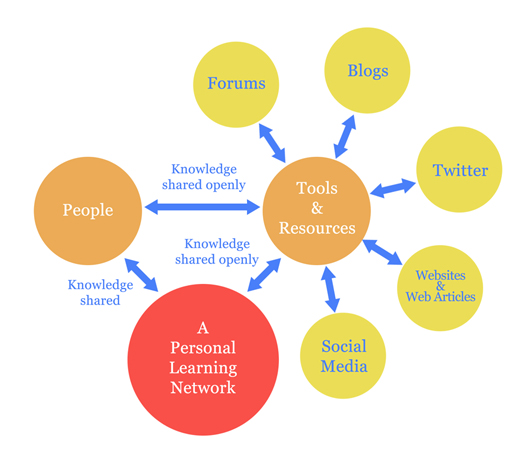My work for activity 19, I did this weeks tasks in a different order! Week 8 Course design task re-evaluated
Course structure (weekly lessons)
Lesson 1 - Introduction to the Internet
Lesson 2 - Being Safe Online
Lesson 3 - Contributing to the internet: Blogging, Wiki’s, Video sites
Lesson 4 - Using Social Media
Lesson 5 - Creating digital media
The approach to this course on becoming introduced to the Web2.0 internet will take a more experience based approach using the connectivism theory and will happen exclusively online. Instead of providing OER to facilitate an understanding of the knowledge represented, learners undertaking the course will learn through building connections to resources, communities and individuals. This places more onus on the learner to become engaged in seeking out relevant information and gaining skills in evaluating its appropriateness, instead of being handed information which has been cherry picked, which could lead to the narrowing of view on a specific subject.
Learning and knowledge rests in diversity of opinions.
Lesson 2, 3. Both these lessons could be used to explore various opinions on how to be safe and how to contribute to the internet. For example in Lesson 2, Being Safe Online - will mean different things to differing groups of uses, such as young children being warned of the pitfalls of online chat rooms or social sites, through to older citizens, being advised about giving personal or financial information out on the internet. These issues are social and contextual, and become open to interpretation and opinion; learners could therefore be asked to initially try to define what it means to be safe online, then find evidence which either supports or contradicts their initial definition, and share links to the information gathered in a forum.
Learning is a process of connecting specialised nodes or information sources.
This could be done throughout the course by informing and encouraging learners during the introductory lesson 1. The course will place the responsibility of finding resources on the learners themselves, so creating a repository space for students to place interesting or pertinent links to content, could help to facilitate Siemens point.
Learning may reside in non-human appliances.
The community of online learners will do their learning via sharing ideas and concepts on forums both institutionally and in a wider context. So, they will have a small community of learners studying the course using the institutions forum, where new ideas and knowledge found will be housed, but students will be encouraged to join wider communities especially in Lesson 3 and 4. In these lessons, they will be expected to contribute to blogs and engage in social media, opening up their ideas to other learners and experts in the field, which could strengthen their ideas or help them to understand the limitations of those ideas.
Capacity to know more is more critical than what is currently known.
Finding information on the internet is a skill in and of itself. In Lesson 1, the language of internet searching would need to be explained, as knowing where to find and how to access information is an important factor of success.
Nurturing and maintaining connections is needed to facilitate continual learning.
Fostering a good community of contribution by showing learners how and what to share with fellow learners (Lesson 2 example in the “Learning and knowledge rests in diversity of opinions.” section) far outweighs an individualist approach. For example, a learner seeking information and finding it ends the process of learning, however, fostering a connection based approach means the process of learning won’t end; as long as learners stay interested and engaged they will keep pushing the knowledge forward.
Ability to see connections between fields, ideas and concepts is a core skill.
This point could be facilitated by asking learners to take what is learned in their small course community and looking to other fields or ideas communities which have formed on the internet.
Currency (accurate, up-to-date knowledge) is the intent of all connectivist learning activities.
Discussing information and sharing it in forums means that ideas are continually being reviewed and reevaluated, meaning that they are never stationary and always being improved on or tested for validity. By not relying on any pre existing course materials and allowing learners to find up to date articles or books or ‘currency’ to base their discussion on, it facilitates the keeping of knowledge, fresh and relevant, reducing the risk of learners basing their own ideas on out of date information.
Decision making is itself a learning process. Choosing what to learn and the meaning of incoming information is seen through the lens of a shifting reality. While there is a right answer now, it may be wrong tomorrow due to alterations in the information climate affecting the decision.
Again, allowing learners to share and bring their own relevant information to base discussions of, allows them to develop decision making and analytical skills. They will only present information to the community that they think has relevancy.
